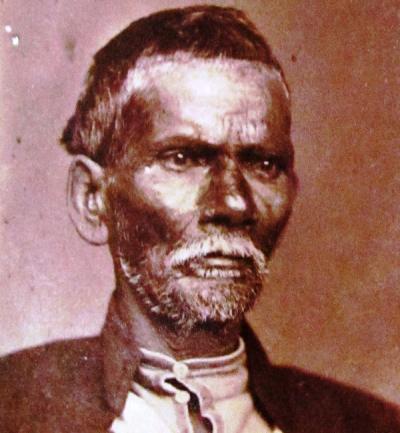This year marks the 177th anniversary of the arrival of the indentured labourers in Mauritius which will be commemorated on 2nd November 2011 at the Aapravasi Ghat World Heritage Site in Port Louis. Who exactly were these early indentured workers who first set foot on Mauritian soil so many decades ago?
The Pioneer Indentured Labourers
Recent research at the Mauritius National Archives has provided some new information on the indentured labourers who came to Mauritius on the ship the Atlas on Sunday, 2nd November 1834. The story of these pioneer Indian labourers began almost two months earlier in Calcutta, India.
On 10th September 1834, 36 Hill “Coolies” (or “kuli” is a wage earner) who were also known as Dhangars (originally from the hills of Bihar in eastern India who were then working and living in Calcutta) signed a five-year labour contract with George Charles Arbuthnot of Hunter-Arbuthnot & Company, a major British trading company based in Mauritius, in the presence of C. McFarlan, at the Calcutta Police Head Office. MacFarlan, the Chief Magistrate of Calcutta, read and explained in detail the indenture contract to the Indian labourers with the help of an Indian interpreter who resided in Calcutta.
Once the labourers agreed to the terms and conditions, they placed their thumb mark on the contract and on a separate list, which contained the names of the 36 Coolies, they placed an ‘X’ next to their names. The sirdar of these labourers was called Sooroop who was assisted by Subaram. In all, there were 30 males and 6 females among Arbuthnot’s indentured workers, some of their names were Callachaund, Dookhun, Bhomarah, Bhoodhoo, Bigna, Champah, Lungon, and Budhram.
The indenture labour contract which these labourers signed was written in Bengali. Furthermore, the monthly salary for the males was 5 rupees per month and for the females only 4 rupees per month. The sirdar was paid 10 rupees per month and the assistant sirdar around 8 rupees per month. In fact, they all received six months’ pay in advance before boarding the Atlas. It was Hunter Arbuthnot & Company that paid for their journey from Calcutta to Port Louis. As a result, one rupee was deducted from their monthly wages by that British company for the return passage to India and they were also going to be provided with food, clothing, lodging and medical care.
The Arrival of the November 1834 Indentured Workers
On the same day that the labour contract was signed, MacFarlan sent a letter to H. Prinsep, the Secretary to the Government of the Bengal Presidency, informing him of the agreement. The Chief Magistrate requested the Vice-President and Governing Council of the Bengal Presidency to give their stamp of approval to the contract and to allow the labourers to sail for Mauritius.
On 15th September, the Vice-President in Council gave his assent to the contract. On the very same day, the 36 Hill Coolies embarked on the Atlas and began their historic voyage to British Mauritius. The Atlas was under command of Captain Hustwick and was also transporting George Arbuthnot and a handful of free passengers as well as a large cargo of rice.
After a long voyage of more than six weeks, the Atlas sailed into Port Louis harbour on Sunday afternoon, 2nd November 1834. However, George Arbuthnot had to wait until the following day before starting the formalities in order for his labourers to be landed on Mauritian soil. On Monday morning, 3rd November, Arbuthnot, wrote an official letter on behalf of Hunter-Arbuthnot & Company to Governor Nicolay, which requested that:
“they be allowed to land 36 Hill Coolies from the ship Atlas, whom they intend to employ on their Estate, under guarantee that they shall not become a charge on the Colony”.
Hunter-Arbuthnot & Company provided Governor Sir William Nicolay with a financial guarantee which was kept in trust by the local colonial government in the Colonial Treasury. In addition, it would be returned to that British company after the five-year contract of the labourers had expired. As a result, during the afternoon of 3rd November, permission for the landing of the labourers was given by the British governor. However, it was only on Tuesday morning, 4th November, that the 36 Hill Coolies were landed close to the old Customs House, less than 200 meters from the present-day Aapravasi Ghat.
Later that same day, after having completed all the necessary formalities, Arbuthnot’s Indian workers were taken to Belle Alliance Sugar Estate or Antoinette Sugar Estate near the present-day village of Piton, in Riviere du Rempart district. In 1834, Belle Alliance was owned by Hunter-Arbuthnot & Company and it stretched over an area of 502 acres and had a workforce of between 190 to 200 slaves. The Indian labourers worked from sunrise to sunset, six days a week and they were also required to perform light duties on Sundays. Between 1834 and 1839, they worked side by side with the slaves and then the apprentices of Belle Alliance or Antoinette in the sugarcane fields.
The Significance of November 1834
Huguette Ly Tio Fane Pineo, a Sino-Mauritian historian, explains that the event of 2nd November 1834 is important because:“Hunter Arbuthnot and Company were therefore the first planters to follow the administrative procedure designed to ensure the safe transfer and return of emigrants to their home country.”
At the same time, the arrival of Arbuthnot’s labourers is the particular event that is commemorated each year on 2nd November at the Aapravasi Ghat World Heritage Site. In 1950, Dr.Brenda Howell, a British historian, called these first Indian labourers “the pioneers of a migration which was eventually to transform the character of Mauritian life and industry”. After all, they were the precursors of more than 455,000 indentured labourers who arrived between January 1835 and August 1910 in British Mauritius.
SOME NEW INFORMATION – 2ND NOVEMBER 1834: The Arrival of the Pioneer Indentured Labourers in Mauritius
- Publicité -
EN CONTINU ↻



